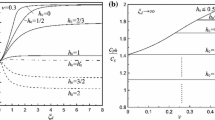Abstract
In this investigation, general approximate solutions for the stress intensity factor (SIF) and configuration force (CF) are derived, respectively, based on the Eshelby theory for the interaction between an inhomogeneous inclusion of arbitrary shape undergoing a stress-free transformation strain and plane stress mode II crack. For common inclusion shapes, some simplified approximate formulae are also developed. Then, the relationship between the normalized CF and SIF is discussed, as well as the effects of inclusion shape, location, and size on the CF and SIF of a plane stress mode II crack. To give deep insight into the complex three-dimensional interaction between an inclusion undergoing a stress-free transformation strain and a crack, two typical cases of the triaxial stress state are analyzed, and no significant difference occurs among most engineering materials.
Similar content being viewed by others
References
Ubale, A.U., Deshpande, V.P.: Effect of manganese inclusion on structural, optical and electrical properties of ZnO thin films. J. Alloy Compd. 500, 138–143 (2010)
Park, S., Ji, H.Y., Kim, M.J., Peck, J.H., Kim, K.: Enhanced quantum efficiency of amorphous silicon thin film solar cells with the inclusion of a rear-reflector thin film. Appl. Phys. Lett. 104, 073902 (2014)
Pappacena, K.E., Singh, D., Ajayi, O.O., Routbort, J.L., Erilymaz, O.L., Demas, N.G., Chen, G.: Residual stresses, interfacial adhesion and tribological properties of MoN/Cu composite coatings. Wear 278, 62–70 (2012)
Liu, M., Wang, X., Liu, Q., Gao, H.: Application of smart coating sensor in crack detection for aircraft. Appl. Mech. Mater. 152–154, 554–559 (2012)
Sun, Y., Liu, M.: Analysis of the crack penetration/deflection at the interfaces in the intelligent coating system utilizing virtual crack closure technique. Eng. Fract. Mech. 133, 152–162 (2015)
Freund, L., Suresh, S.: Thin Film Materials: Stress, Defect Formation and Surface Evolution. Cambridge University Press, Cambridge (2003)
Steffensen, S., Kibsgaard, R.L., Jensen, H.M.: Debonding of particles in thin films. Int. J. Solid Struct. 51, 2850–2856 (2014)
Sun, Y., Yang, J., Wang, B., Liu, M.: The interaction of the plane stress mode I crack with an inhomogeneity undergoing a stress-free transformation strain. Int. J. Appl. Mech. 7, 1550040 (2015)
Zhou, K., Hoh, H.J., Wang, X., Keer, L.M., Pang, J.H., Song, B., Wang, Q.J.: A review of recent works on inclusions. Mech. Mater. 60, 144–158 (2013)
Taya, M., Chou, T.W.: On two kinds of ellipsoidal inhomogeneities in an infinite elastic body: an application to a hybrid composite. Int. J. Solid Struct. 17, 553–563 (1981)
Wang, X., Pan, E., Chung, P.W.: On a semi-infinite crack penetrating a piezoelectric circular inhomogeneity with a viscous interface. Int. J. Solid Struct. 46, 203–216 (2009)
Eshelby, J.D.: The determination of the elastic fields of an ellipsoidal inclusion and related problems. Proc. R. Soc. Lond. Ser. A 241, 376–396 (1957)
Lambropoulos, J.C.: Shear, shape and orientation effects in transformation toughening. Int. J. Solid Struct. 22, 1083–1106 (1986)
Eshelby, J.D.: The force on an elastic singularity. Philos. Trans. R. Soc. Lond. Ser. A 244, 87–112 (1951)
Li, Z., Chen, Q.: Crack-inclusion interaction for mode I crack analyzed by Eshelby equivalent inclusion method. Int. J. Fract. 118, 29–40 (2002)
Yang, L., Chen, Q., Li, Z.: Crack-inclusion interaction for mode II crack analyzed by Eshelby equivalent inclusion method. Eng. Fract. Mech. 71, 1421–1433 (2004)
Li, H., Yang, J., Li, Z.: An approximate solution for the plane stress mode I crack interacting with an inclusion of arbitrary shape. Eng. Fract. Mech. 116, 190–196 (2014)
Yang, J., Li, H., Li, Z.: Approximate analytical solution for plane stress mode II crack interacting with an inclusion of any shape. Eur. J. Mech. A/Solid 49, 293–298 (2015)
Zhou, R., Li, Z., Sun, J.: Crack deflection and interface debonding in composite materials elucidated by the configuration force theory. Compos Part B 42, 1999–2003 (2011)
Brencich, A., Carpinteri, A.: Stress field interaction and strain energy distribution between a stationary main crack and its process zone. Eng. Fract. Mech. 59, 797–814 (1998)
Withers, P.J., Stobbs, W.M., Pedersen, O.B.: The application of the Eshelby method of internal stress determination to short fibre metal matrix composites. Acta Metall. 37, 3061–3084 (1989)
Li, Z., Yang, L.: The application of the Eshelby equivalent inclusion method for unifying modulus and transformation toughening. Int. J. Solid Struct. 39, 5225–5240 (2002)
Mura, T.: Micromechanics of Defects in Solids, 2nd edn. Martinus Nijhoff Publishers, Dordrecht (1987)
Mura, T.: A theory of fatigue crack initiation. Mater. Sci. Eng. A 176, 61–70 (1994)
Gross, D., Mueller, R., Kolling, S.: Configurational forces-morphology evolution and finite elements. Mech. Res. Commun. 29, 529–536 (2002)
Sharma, P., Ganti, S.: Size-dependent Eshelby’s tensor for embedded nano-inclusions incorporating surface/interface energies. J. Appl. Mech. 71, 663–671 (2004)
Zhou, K., Keer, L.M., Wang, Q.J., Ai, X.L., Sawamiphakdi, K., Glaws, P., Paire, M., Che, F.: Interaction of multiple inhomogeneous inclusions beneath a surface. Comput. Method. Appl. Mech. Eng. 217, 25–33 (2012)
Wang, X., Zhou, K.: Long-range interaction of a line dislocation with multiple multicoated inclusions of arbitrary shape. Acta Mech. 224, 63–70 (2013)
Chen, Q.D., Xu, K.Y., Pan, E.: Inclusion of an arbitrary polygon with graded eigenstrain in an anisotropic piezoelectric half plane. Int. J. Solid Struct. 51, 53–62 (2014)
Ippolito, M., Mattoni, A., Colombo, L., Pugno, N.: Role of lattice discreteness on brittle fracture: atomistic simulations versus analytical models. Phys. Rev. B 73, 104111 (2006)
Shi, J., Li, Z.: The interaction of an edge dislocation with an inclusion of arbitrary shape analyzed by the Eshelby inclusion method. Acta Mech. 161, 31–37 (2003)
Author information
Authors and Affiliations
Corresponding author
Rights and permissions
About this article
Cite this article
Sun, Y., Yu, X., Jia, W. et al. The interaction of a mode II crack with an inhomogeneity undergoing a stress-free transformation strain. Acta Mech 229, 1311–1320 (2018). https://doi.org/10.1007/s00707-017-2041-y
Received:
Published:
Issue Date:
DOI: https://doi.org/10.1007/s00707-017-2041-y




